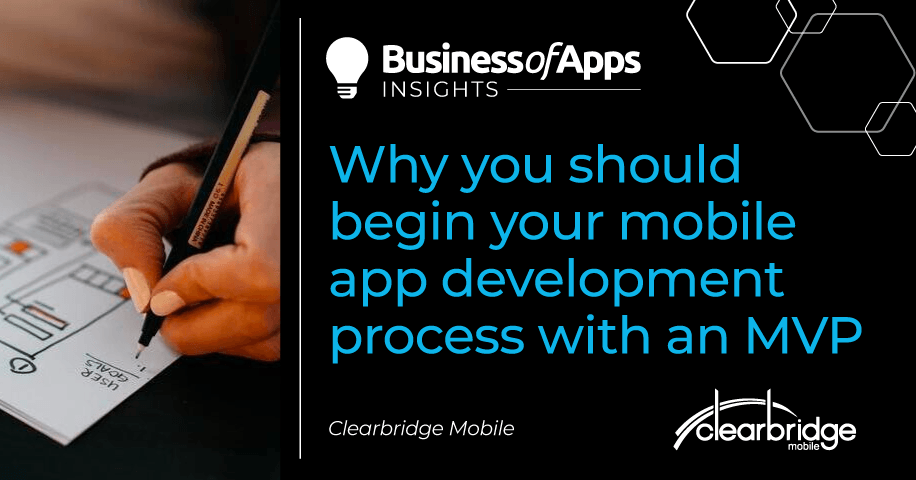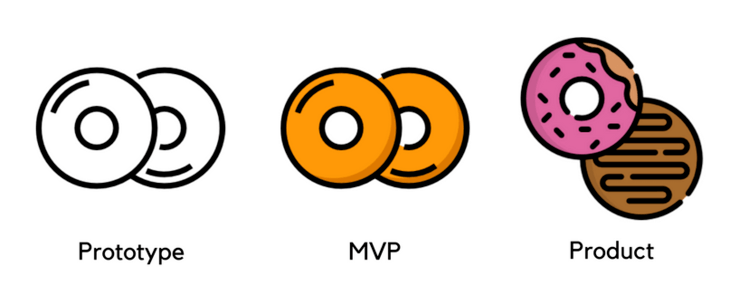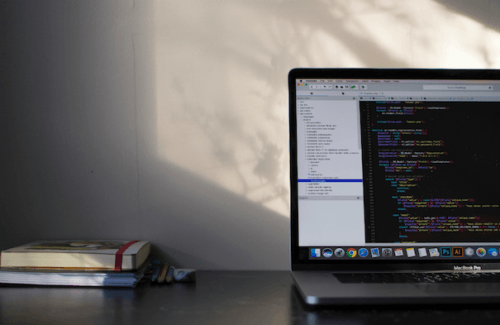What do extremely popular apps like Instagram, Uber, and Spotify all have in common? Each of them began their life as a Minimum Viable Product (MVP). From these small but functional beginnings, their developers tested their assumptions and the viability of the concept. From there, with the aid of customer feedback, they crafted the best functions to add. Eventually, they grew into the powerhouses we know today.
Your business can follow in these footsteps. But you’ll first need to understand what the MVP mobile app development process is, and what benefits it can bring to your business. Let’s dive right in.
MVP defined
A Minimum Viable Product, or MVP, is exactly what its name implies: the most basic functioning version of your product, in this case, your mobile app. But why would you do this? Put simply, an MVP allows your developers to test your app idea with your target audience. It’s the most basic form of your app that can be tested by real users. Additionally, the MVP can work as the foundation for your future, more robust app.
The key aspect of an MVP is that it includes the most fundamental features you think are needed for success. Once potential users have your MVP, they can provide valuable feedback. That feedback is what can validate – or invalidate – all the assumptions you’ve made about your audience and the app itself; including if it even does what you intend. Furthermore, your development team can use these insights to decide what areas of the app need improvement, and what features need to be added next.
Build-measure-learn
Let’s say you’ve decided to develop an app. The first step requires you make a few assumptions, such as:
- Users to target
- App design
- Marketing strategy
- Effective architecture
- Monetization models
However, no matter how certain you may be about these assumptions, your product can only succeed if they’ve been validated.
MVP development utilizes an iterative, “build-measure-learn” process. This process allows you to easily validate – or invalidate – each of your assumptions with limited risk. This iterative process is designed to help you identify user pain points and decide how to best address them. This is achieved by continuously testing your assumptions against user feedback, and making adjustments to the app as new information becomes available.
The “build-measure-learn” process dictates that you launch your MVP, allow users to test your assumptions, and then collect feedback that guides future iterations.
MVP doughnut
Source: Medium
Benefits of an MVP
With more apps entering the market every day, beginning your development process with an MVP has never been more important. With an MVP, you can actually gauge how unique or useful your app idea actually is. It also provides you with the shortest possible process to reach the market, thanks to real users evaluating your app.
Performance marketers are shifting budgets to Browser Advertising 📈
Learn how brands like Walmart, Expedia and Nike drive incremental growth by reaching high-intent users before they hit search.
Get Your Free GuideStakeholder buy-in
If your business is like many others, you rely on an investor or stakeholder buy-in to secure funding before you can begin any mobile app development. The key to convincing your stakeholders is in proving that the product you’re pitching has the ability to produce the desired outcome; for example, increasing revenue or reducing costs.
Developing an MVP is perhaps the most effective way to do this. This is because it allows you to test out your idea on real-world users before you ever pitch it to an investor. When you do approach your stakeholders, you’ll already have proof of the app’s market validity.
When it comes down to it, stakeholders want to invest in products that will be successful. An MVP not only proves the viability of the project but also provides something stakeholders can see and use. What’s more, once you get that buy-in, the product can launch quickly, without forcing investors to wait to see a return.
Focus on functionality
During the development phase, it can be tempting to add more and more features. This “scope creep” eats into the budget and prolongs development time. It also causes you to lose focus on the main problem you originally set out to solve.
Starting with an MVP helps combat scope creep by keeping you focused on your app’s most basic functionality. This allows you to test your concept without spending too much time and money.
If you focus on your app’s most fundamental functions you can test the market effectively and learn what you need from your target audience to dictate future iterations.
Quicker to market
One of the most important benefits of building an MVP is that your time to market is significantly accelerated. As soon as you have your app’s core functionality working, you can release it. With that first product version, you can quickly test your assumptions and gather feedback on the core solution and desired features.
The bigger and more complicated the first version of your app is, the longer it will take to get to market. What’s more, you might end up with features no one uses, and long, expensive bug fixes.
The fear is that someone will release a functional app with your solution before you can. The key is to keep your initial release as minimal as possible and make future releases incremental. That way you not only get to market quickly, but you can also stay responsive to the market at the same time.
Validate business concepts
Perhaps the biggest benefit that comes from an MVP is the ability to test your business concepts. When you offer a focused app with only a core set of features you’re able to verify that your product concept is something your audience needs. This, in turn, gives you the opportunity to change the product’s direction early based on your findings.
After you launch your MVP, you can identify your most active users and how they interact with your app. This information can then be used to alter app functions to suit these users even better.
On the other hand, trying to make changes to a feature-heavy app is much harder – you might even be forced to rebuild from the ground up.
Gain an understanding of customer needs
The importance of data you collect through your MVP and detailed target audience research cannot be overstated. The feedback you receive from the early adopters of your MVP is much more valuable than the assumptions you made when you began the development process.
The quicker you can test your product with real-world users, the more effective your development process will be. Your users will tell you which features they love most, which features aren’t needed, and which features should be added in the next release.
High ROI with low risk
It may be tempting to put all the work into producing a highly functional, polished, and large-scale product. But it’s important to remember that mobile app development is best when it is an iterative process.
In reality, those highly functional, polished, and large-scale apps take years, big budgets, and lots of time and effort to create. The most popular apps, including Facebook, Instagram, Uber, and Spotify all started as bare-bones MVPs and grew into the behemoths they are today.
With a relatively inexpensive MVP out in the market, you can start collecting revenue immediately without the risk of a fully-functional app that misses the mark.
Find the right monetization strategy
In the end, your app needs to be profitable. That means determining the best mobile app monetization strategy for what you are offering. There are plenty of monetization strategies, each with its own merits, but deciding which is best for your app can be difficult.
With so many options available it’s certainly possible to assume one will work, and be completely wrong. Again, this is where the MVP process’s ability to test assumptions comes into play. If, for example, you’ve decided on an in-app-purchases model, you can use your MVP to test users’ willingness to pay for upgrades and add-ons. However, if you find users aren’t buying as much as you predicted, this may be an indication you need to try a different monetization strategy.
In conclusion
It’s undeniable that creating an MVP is a critical part of app development success. Without it, you run the risk of all your assumptions being wrong, and your fully-functional app falling flat. That means lots of extra money, time, and effort to rebuild from the ground up.
The key takeaway should be that an MVP allows you to start smaller and quicker, and build your app iteratively based on feedback from your real-world users. This ultimately results in a more well-rounded and polished product – not to mention more revenue and return on investment.












